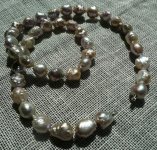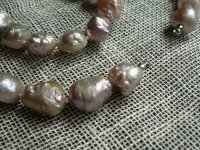C
You are using an out of date browser. It may not display this or other websites correctly.
You should upgrade or use an alternative browser.
You should upgrade or use an alternative browser.
P
pattye
Guest
HUMMM,
I'd like to know, too! I have some fab ones like this, I also am curious if it is primarily in fw.
Pattye
so many pearls, so little time
I'd like to know, too! I have some fab ones like this, I also am curious if it is primarily in fw.
Pattye
so many pearls, so little time
Sueki
Pearl Collector & Designer
Ohhhh,
Yes please, I'd love to know any info. too.
I have some of these and the lustre is incredible - some look as though they have been burnished with gold.
Yes please, I'd love to know any info. too.
I have some of these and the lustre is incredible - some look as though they have been burnished with gold.
P
PearlStruck.com
Guest
I'm sorry, I don't understand the question. When you say "drusy", do you mean the bumps?
Last edited by a moderator:
C
CLICLASP
Guest
Ingykiz
New Member
I have been a little curious about this myself. I almost bought a strand off of Ebay from NYlady but I was not quite sure if it was a fair price. Is this an unusual, undesireable pearl? I thought they would be fashion forward if I layered a few strands. Any comments?
Sueki
Pearl Collector & Designer
It's late here, and so I apologise for posting and running.
The pearls have a lumpy, bumpy, pimply surface, some wrinkles, with high mirror lustre and some flattish sides.
The colours are amazing, too. A few look like burnished gold.
Ingykiz, I intend to make a double row necklace with them - if I can just stop handling and admiring them long enough to get on with it......
But I don't know anything about them other than they are gorgeous, so have no idea of value.
The pearls have a lumpy, bumpy, pimply surface, some wrinkles, with high mirror lustre and some flattish sides.
The colours are amazing, too. A few look like burnished gold.
Ingykiz, I intend to make a double row necklace with them - if I can just stop handling and admiring them long enough to get on with it......
But I don't know anything about them other than they are gorgeous, so have no idea of value.
P
PearlStruck.com
Guest
Oh, okay...interesting! I'm curious to learn more, and looking forward to an explanation as well. Thank you for posting the "zoomed-in" image.
jshepherd
Pearl Paradise
In Chinese these types of pearls are referred to as "chi mau zhu"; literally meaning "thorn (chi)", "hair (mau), "pearl (zhu)". Basically when run together it means "bristle pearl".
I am not sure how or why they are produced. But I understand it is related to pearl sac damage and/or small pearls combining with larger.
I am not sure how or why they are produced. But I understand it is related to pearl sac damage and/or small pearls combining with larger.
C
Casey.R
Guest
I'm not sure what to make of those pearls. But they seem popular so they must be nice in person.
C
CortezPearls
Guest
We have similar pearls in our harvests every once in a while. They are just "baroques" to us, but -I don't know if you see darks spots here and there in some of the pearls- we consider most to be discards or "rejects". Some of the bumps and pimples contain much protein deposition, causing many of the pearls to crack. It may not be the case with these (being FWP) but I would certainly not like having a customer bringing in a cracked Cortez Pearl...we definitively will not risk it!!!
I agree with Jeremy on their origin: a malfunctioning pearl sac, probably due to environmental stress. Since we seed only one nucleus per oyster it would not be our case...but in FWPs anything is possible. Love the name "Chi Mau Zhu" for these pearls...sounds good.
I agree with Jeremy on their origin: a malfunctioning pearl sac, probably due to environmental stress. Since we seed only one nucleus per oyster it would not be our case...but in FWPs anything is possible. Love the name "Chi Mau Zhu" for these pearls...sounds good.
C
CLICLASP
Guest
Thanks a lot Jeremy and Douglas, I was sure you would know why
Now I know why !
(The oysters too were curious in Alice in wonderland)
Now I know why !
(The oysters too were curious in Alice in wonderland)
effisk
thou shall read the book
There's an interesting article on Pearl World about such pearls found in abalones if I remember well. It was published about 4 or 5 months ago.
C
CortezPearls
Guest
Thanks for pointing this source out...gotta go back to my old Pearl World issues to hunt this one down. It would be interesting to find the similarities between different pearl bearing species to obtain a broader view (the big picture).
Similar threads
- Replies
- 5
- Views
- 733
- Replies
- 7
- Views
- 1K


